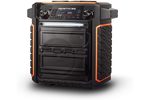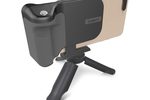Connect all of your legacy devices to your modern USB-C notebook.
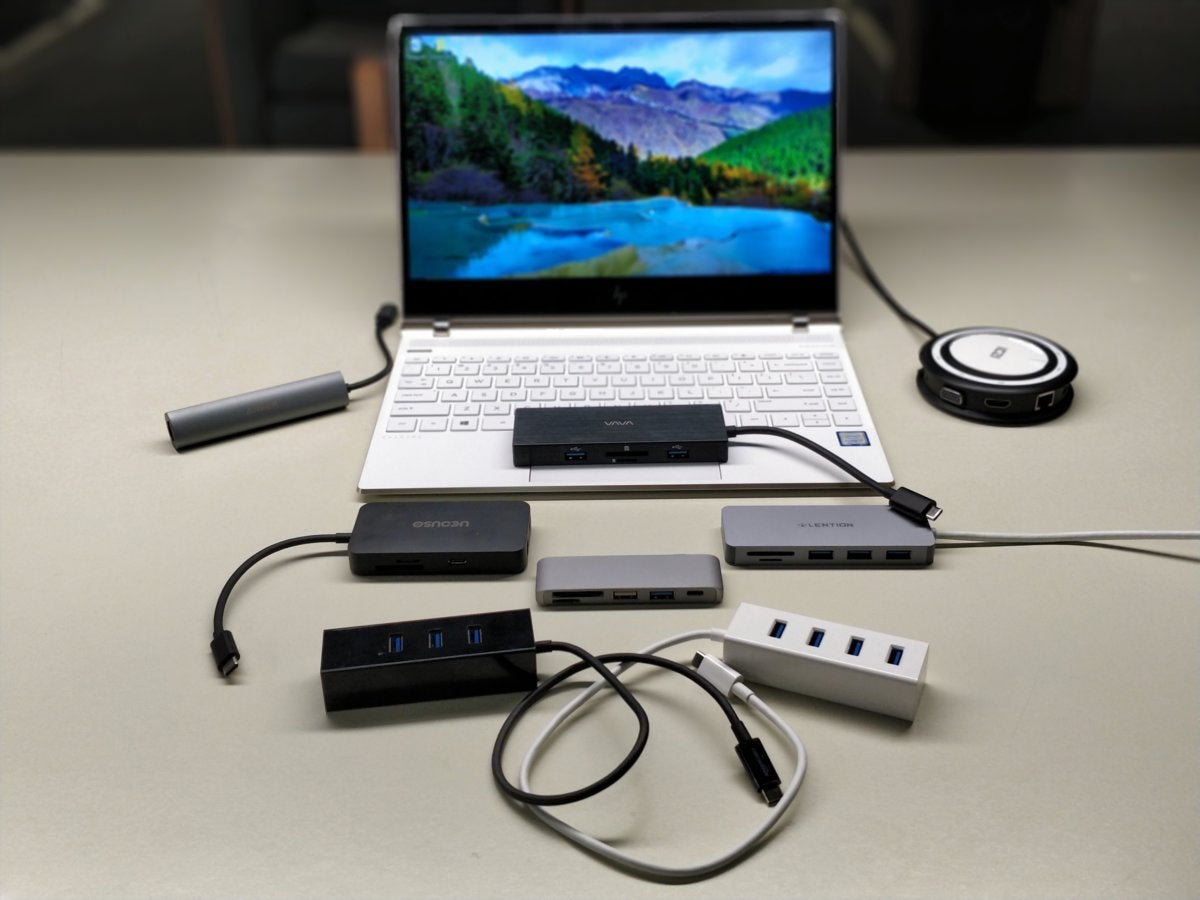
TODAY’S BEST TECH DEALS
Picked by PCWorld’s Editors
TOP DEALS ON GREAT PRODUCTS
Picked by Techconnect’s Editors
A USB-C hub allows you to add connections and ports that your laptop or tablet lacks: an HDMI connection, for example, or an SD card slot. But it’s also important to know whether what you’re looking for is a true USB-C hub, or a more powerful, pricier Thunderbolt dock. Both have their uses.
Laptops with USB-C ports are becoming more and more common, as the world moves away from slower, somewhat inflexible USB-A ports to this faster, more versatile connection standard. Some laptops only have USB-C connections—that means a USB-C hub is essential if you want to connect a wired USB mouse or keyboard, or an older wired printer.
Fortunately, there are so many USB-C hubs available with various combinations of legacy I/O that finding one to meet your particular needs is as easy as ordering off a menu. We’ve divided our picks into two categories: basic and full-featured, the latter denoting hubs that offer greater extensibility, including charging.


Expect to pay about $20 for the “basic” category of USB-A/SD hubs. The more advanced full-featured options can run up to $70 or so, depending upon which ports are included. For whatever reason, too, the shelf life of a USB-C hub is short! If one of our listings is sold out, there may be an “upgraded” replacement available.
We’ve tried a sampling of hubs to point out details you can’t tell from the specs, like whether the ports are too crowded or the hub runs a bit hot. Below our picks you can find information on how to choose a USB-C hub versus Thunderbolt and how we tested these hubs in our evaluations.
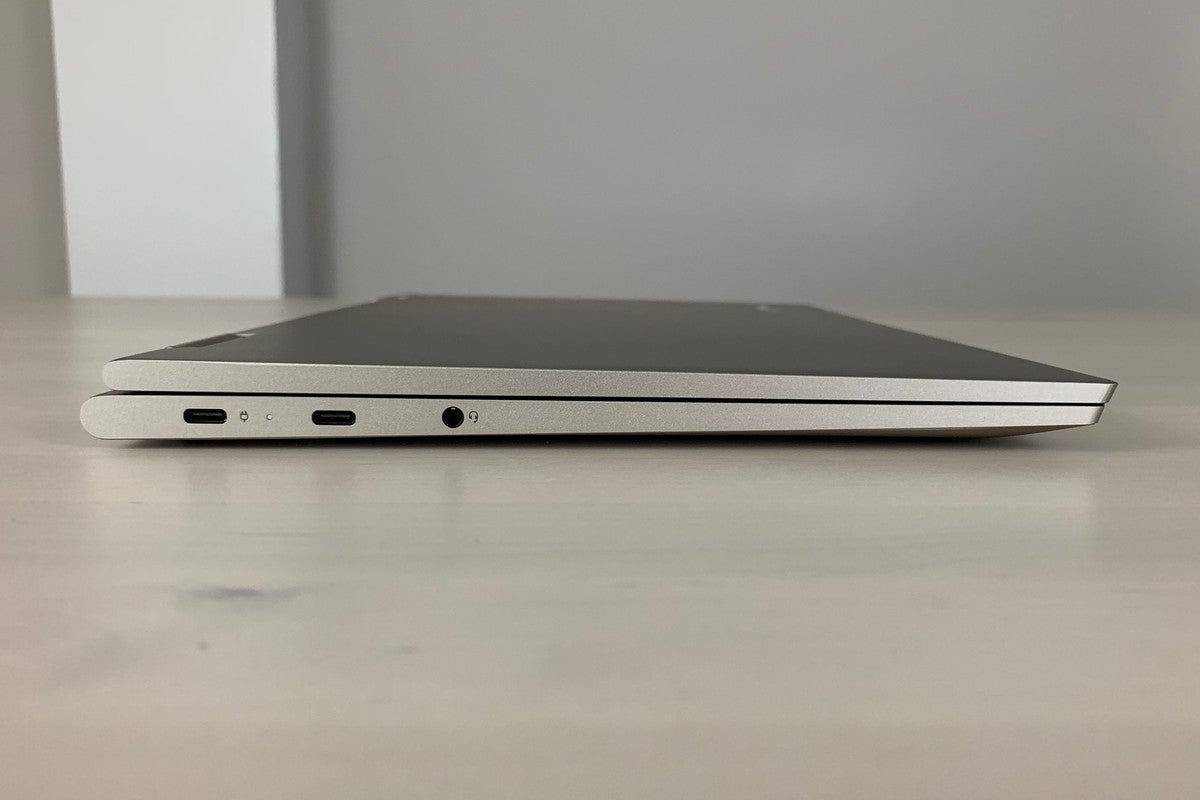
Ben Patterson/IDG A USB-C hub connects to the USB-C on the side of your laptop, such as on this Lenovo Yoga C740. In this example, the left port is used for charging, so you’d need to buy a USB-C hub with a charging input to use with this slot. (Of course, you could also buy a hub without charging capabilities and use it in the other USB-C port, to the right of the charging port.)
The best basic USB-C hubs
You shouldn’t have to think too hard about a basic USB-C hub. Look for a good price, consider whether you want to pay a little extra for something like ethernet, and try to find products with a good warranty for added peace of mind. Avoid any hubs that connect directly to the port rather than using a cord, as they can block other ports. Also look for longer cords, so hubs don’t dangle from tablets, for instance.
AUKEY CB-C72 Multiport USB-C Hub

If you’re considering a USB-C to USB-A hub like the AmazonBasics L6LUD012-CS-R, it’s worth weighing Aukey’s hub first. That’s because (at press time) Aukey’s hub was cheaper and gave you a different complement of ports.
The CB-C72 is a replacement for the CB-C65, which we recommended previously and has since gone out of stock. It’s nearly identical in size (3.8 x 1.1 x 0.4 inches) and weight (1.9 oz./0.12 lb.), with a cord an inch shorter at just under six inches. The CB-C65 had three USB-A ports, which may be handy if you want to connect a wired mouse, keyboard, and an external hard drive. The CB-C72 has only two USB-A connections, but the spacing between the ports is sufficient. There are also SD and microSD slots, plus an HDMI output. (It does lack an ethernet port, however, so you’ll be forced to use Wi-Fi.)
There were some quirks in the CB-C65 that may be repeated in the CB-C72. In the earlier model, Aukey asked you to insert the microSD card upside down, though it thankfully did away with the awkward spring-loaded slot that sucks your card into many competing products. As this is a basic hub, there’s no charging input, which means your laptop or tablet will need a second USB-C port or a dedicated power cord for charging while using the hub.
AmazonBasics USB 3.1 Type C to 3 Port USB Hub with Ethernet (L6LUD001-CS-R)

The AmazonBasics L6LUD001-CS-R provides three USB 3.1 Type A ports, plus Gigabit ethernet, to your laptop’s existing USB-C port. There are no HDMI or charging inputs; this is merely an incremental step up from the AmazonBasics L6LUD012-CS-R, which forgoes the ethernet capabilities.
This hub is handy for those who don’t have or don’t trust Wi-Fi on the go. The lengthy 14-inch cord adds some flexibility to your desktop layout. The hub performed comparably to the others we’ve tested, and there weren’t any issues with temperature or power.
At press time, the price was only $3 or so above the price of the aforementioned AmazonBasics L6LUD012-CS-R, which makes this a no-brainer if you just want a basic hub. Though the hub ships in both black and white, we noticed Amazon will occasionally discount one or the other by a few dollars.
The best full-featured USB-C hubs
Upper-tier USB-C hubs typically feature even more ports, including ethernet, HDMI, and power inputs. This is essentially the dongle equivalent of a docking station. Many of these fancier hubs share the same basic six-inch cable of their more basic cousins, meaning they may dangle from tablets and some laptops.
All of these hubs use a single display connection, which is fine for everyday use. But if you have the desk space, even a pair of basic 1080p displays can make a difference. We tested a Lasuney dual-HDMI hub, which you’ll find in our list of reviewed products at the end. Unfortunately, it didn’t make the cut because of performance issues.
VAVA VA-UC010
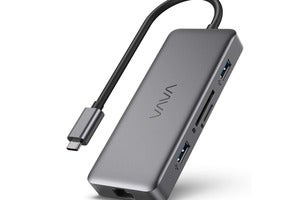
The VAVA VA-UC008 offers a compete docking station within an attractive, professional chassis that’s priced affordably. It provides virtually all of the connectivity you’ll need: three USB-A (two USB 3.0, 1 USB 2.1) ports, separate microSD/SD slots, 4K (at 30Hz) HDMI capabilities, and Gigabit ethernet. It also allows you to charge your laptop through a separate USB-C power input, up to 100W. It only lacks an audio jack.
At nearly five inches long and two inches wide, the VA-UC008 is a bit larger than some other hubs, and what appears to be about six inches of cord length is still a bit too short if your laptop’s USB-C port is mounted alongside the display panel. But the USB-A ports are smartly divvied up so that even fat novelty USB sticks shouldn’t interfere with other connectors. We’re not in love with the USB 2.0 port, but it can be assigned to a mouse or keyboard with no issue.
We tested a prior generation of hub from Vava, and it offered excellent performance without getting hot.
Anker (Upgraded) USB-C Hub Adapter (7 in 1, A83460A2)

Can a USB-C hub feel elegant? This one does. Anker’s 7-in-1 USB-C hub feels surprisingly weighty (3.5 ounces), with a premium metallic (aluminum and polycarbonate) sheen. It’s also a bit more expensive than its rivals. Anker’s hub was among the coolest we’ve tested under load, at about 87 degrees.
Overall, Anker’s hub is well designed, with adequate spacing between the two USB-A ports. Instead of three Type A ports, there’s a USB-C connection for data, plus a second USB-C port for power input at up to 85W rated. An HDMI port allows for 4K/30 video or 1080p/60 video to a single external display, standard for the category. Ethernet is excluded, however, so you’ll need to use Wi-Fi instead. Cord length was about 8.5 inches, above the standard 6-inch length.
Anker’s hub was among the fastest we tested to deliver data under load, including simultaneous data transfer between USB-A ports while the SD ports were active. The hub offers an 18-month warranty, and it even ships with a carrying pouch.
QGeeM 7 in 1 Type C Hub

The QGeeM 7-in-1 Hub I received tried to buy me off with an in-box promotion that promised a $10 Amazon card if I left a positive review. It doesn’t need one, as it’s a compact, lightweight little hub that covers all the basics, save Ethernet.
The three USB 3.0 hubs are adequately spaced. An HDMI port at the end of the dock supports a single 4K display at 30 Hz (or 1080p at 60 Hz)—par for the course for a typical USB-C hub. QGeeM’s hub includes support for both SD and microSD slots, using the older, prevalent UHS-I SD card standard. Both cards share the same controller, allowing them to be used one card at a time. It does leave out Ethernet, though.
QGeeM’s Web page indicates that it accepts 100W (3A) power delivery though the USB-C input port, though the in-box documentation says it allows for 60W maximum. Nevertheless, a USB-C charger connected to the port reported that it was charging adequately. Under load the hub wamed to about 94 degrees, a comfortable temperature.
QGeeM doesn’t seem to offer warranty support, and the packaging skimps on niceties like a carrying bag. But this lightweight hub offers everything else a typical user will need, and for a great price.
Other USB-C hubs we tested
Your USB-C hub choices extend far beyond what we’ve recommended. Hubs mix and match different port types, and different form factors, too. Pay attention to our ratings, prices, and the quirks of each hub to find alternatives that may fit your specific needs.
Lention C15

Lention’s C15 USB-C hub falls into the “basic” category, offering just three USB-A Type 3.0 ports, an SD card reader, and a microSD/TF reader—and that’s it. Note that the USB-A ports are spaced far enough apart to support standard-sized USB keys and cords, but without much wiggle room.
At just under $21, the C15 is dirt-cheap, and tucks easily into your bag. It’s worth noting that customers who have previously purchased the Lention C15 complained that the hub became unreasonably hot and in some instances apparently interfered with their Wi-Fi connection. We noticed no such issues, and the hub warmed up to just 84 degrees Fahrenheit under load, nothing to sweat about.
The C15 features an extra-long USB-C charging cable that stretches a full foot, substantially more than the several inches other USB-C hub makers allocate. If you’re concerned at the prospect of a dangling hub, the C15 is for you! Just remember to flip the microSD card upsde down before inserting it—it’s an odd quirk that some USB-C hubs suffer from, including this one.
Anker A8331

About the length and shape of a cigar, Anker’s AB331 USB-C hub is for those whose notebook or tablet contains a USB-C port as well as an microSD/SD card slot, such as the Microsoft Surface Go. There are three USB 3.0 Type A ports, Gigabit ethernet, and an HDMI connector—but that’s it. You also get Anker’s good reputation for supporting its products.
The hub looks nice, and there’s even a cloth carrying case for its slim 4 x 0.75-inch form. But the USB ports are jammed close enough that three standard USB sticks next to one another barely fit—and watch out if a USB stick is slightly oversized. Why couldn’t Anker have used both sides of its USB-C hub for ports?
(Since we wrote this review, Anker rearranged the hubs and took about $10 off the price, with this redesigned version.)
The 6-inch USB-C cord is too short for a tablet with a USB-C connector mounted in its top half, from which this hub would dangle. There’s also no USB-C charging. You shouldn’t have any concerns with overheating, though—we copied files from two USB-connected drives while also downloading a file over ethernet, with no slowdown or noticeable heat gain.
At press time the price was $46—a bit high compared to other hubs we’ve tested.
Lenovo USB-C Travel Hub (GX90M61235)

Lenovo’s GX90M61235 USB-C travel hub retains the same black, boxy aesthetic as generations of ThinkPad laptops. The odd pairing of connectors—VGA, HDMI (4K at 30Hz), a single USB 3.0 port, and Gigabit ethernet—means you’ll be using your laptop’s keyboard, possibly a mouse, and either display connector. We’d rather see Lenovo pick either VGA or HDMI and add another USB port.
To be fair though, all of the ports performed as expected and there was no perceptible heat increase when we tried to saturate the ethernet link and USB-C port simultaneously.
There are better deals elsewhere, in terms of price and ports. But if you need a VGA connector, this is one of the few options available.
ICZI IZEC-TH01

ICZI’s IZEC-TH01 breaks from the typical USB-C hub design, forgoing the “candy bar” form factor in favor of a radial hub. Two USB 3.0 Type-A ports are seated next to SD and microSD card slots, HDMI (4K at 30Hz) and VGA, Gigabit ethernet, and a USB-C input connection for charging your laptop.
The extra-long 11-inch cable wraps around the outside of the hub for storage. Sadly, the radial design means other cables (VGA, HDMI, etc.) will end up going in all directions. The center of the hub is taken up by a tray with a magnetic faceplate, large enough to store a dongle. Otherwise, our hub came with no documentation whatsoever, just a 24-month warranty card that’s double the duration of most of its competition.
The IZEC-TH01 does get a bit warm under load (copying files from an SD card to a PC while also copying files from an external hard drive to an SSD, while streaming YouTube) but only to about 88 degrees Fahrenheit. It was a tad faster than other hubs, too. VGA and HDMI can be used simultaneously, and the hub supplies up to 900mA via USB-A for charging.
At 3.75 inches in diameter, IZEC-TH01 is a bit big and bulky for our tastes, especially with cables going every which way. Otherwise it’s a good value, and narrowly misses an Editor’s Choice award.
AmazonBasics L6LUD012-CS-R

This AmazonBasics USB-C hub is as simple as its name suggests: one extra-long (14 inches!) USB-C cable to your PC, connected to four USB 3.1 Type A ports for your legacy devices. Note that most hubs provide 5Gbps USB 3.0 ports, while this one provides 10Gbps USB 3.1 connections; you’d probably never notice the difference.
We connected the hub to two bus-powered drives (one a 2.5-inch hard drive, and the other an SSD) plus a USB 3.0, bus-powered DVD-RW drive. We noticed a slight drop in performance while playing back a DVD and copying data between the two drives. But while one commenter on Amazon’s site noticed a power drop, we were able to burn a disc just fine with our drive—it seems enough power gets through the cable. The hub’s surface temperature didn’t rise more than a few degrees above the ambient temperature.
This hub is cheap, basic, and delivers satisfactory performance for a great price. It lacks an SD slot or some of the other connections other hubs include, however, which are literally available for just a few dollars more.
VAVA VA-UC006

While VAVA’s VA-UC006 packs a ton of functionality in a compact package, several design flaws mar what’s otherwise a solid product. This “kitchen sink” hub measures slightly less than 4 x 2 inches, and combines three USB Type A ports, microSD/SD slots, HDMI (4K at 30Hz), and Gigabit ethernet, plus a USB-C charging port for charging your laptop.
While the 6-inch cord is already shorter than we’d like, that’s just one limitation. The USB ports are spaced too closely together for even a slightly oversized USB key, like a SanDisk Cruzer Glide. The microSD card slot awkwardly forces you to lever the card in with a fingernail, making the card flush with the hub. Because of the hub’s thinness, the ethernet port has a hunged dropjaw, which has the potential to break. During use, the hub heated up to 99 degrees Fahrenheit under load—not uncomfortable, but among the warmest we tried.
We really like VAVA’s goal of combining everything you want it in a small form factor, and we used the VA-UC006 to help set up our tests. But there are other, better alternatives.
Lasuney Triple Display USB Type C HUB

Lasuney’s 10-in-1 hub offers a lot for your money, including an unusual mix of not one but two HDMI ports, and even a DisplayPort. Ethernet’s included, too, letting the hub replace many of your wired connections.
Lasuney’s hub is well made, with good port spacing. It doesn’t get uncomfortably warm, either.
That’s a lot of data to be putting over the USB-C port, though, and while we really like the pair of HDMI ports for dual-display configurations, the fact is that you’ll probably need to limit yourself to a pair of 1080p displays to avoid saturating the bus and slowing down the connection.
The problem we found, though, is that the SD card slot is way too slow. It took twice as long to transfer data compared to other hubs we tested. In all fairness, our other disk-to-disk tests took about the same amount of time. We really like the flexibility that the Lasuney hub offers, but there are other competing hubs that will do a better job.
Keep reading to learn about the essential features for any USB-C hub.
How to choose a USB-C hub versus a Thunderbolt dock
Here’s where to start: Take a look at the peripherals you own, or plan to buy. Do you have an old external hard drive that uses a traditional USB-A cable? Do you manually back up photos from an SLR via its SD card? Or is your Wi-Fi connection unreliable enough that you’d prefer ethernet? Figure out what ports you’ll need.

Mark Hachman /IDG This laptop has several USB-C ports, but if yours has just one, you’ll want to daisy-chain the laptop’s power cord by plugging it directly into the hub, like so.
It’s also important to take stock of your laptop or tablet’s ports: Does it have one USB-C port or two? If your device only has one port, is there a separate charging connection? If your laptop or tablet has a USB-C port and uses it exclusively for charging, you may want a USB-C hub with a dedicated charging input port. Note how much input power it allows for, and confirm that will be sufficient for your laptop. Otherwise, you’ll be forced to choose between charging your laptop and accessing other devices, which makes little sense. But keep in mind that the hub’s power port is for taking power in to your laptop, and not out to a phone. (For that, you can use one of the USB Type-A ports to slow-charge your phone, provided you have the proper cable.)
Some newer, pricier laptops now come with Thunderbolt connections, which offer a greater amount of bandwidth than a traditional USB-C connection. Every device that connects to the USB-C hub shares bandwidth, and in many cases the USB-C port delivers enough so as not to cause a problem.
The usual exception is displays. USB-C delivers enough bandwidth to drive an external 1080p or 4K display, even two. But while USB-C can drive a pair of 1080p displays at a good 60Hz, it can drive 4K displays only up to 30Hz, which is quite fatiguing on your eyes. Of course, this is an issue only for USB-C hubs that support a pair of HDMI or DisplayPort connectors; most have just one.
Thunderbolt’s necessary for the rare case in which you want to power two 4K displays at 60Hz. For that, you’ll need a generally more expensive Thunderbolt dock, which we don’t cover in this article. If you pursue this route, pay attention to other details, too: You’ll need to ensure the dock and monitor support Dual-Mode DisplayPort 1.2 (DP++) ports, and the HDMI ports are rated at HDMI 2.0. The cables, too, need to be rated at the appropriate speeds. A DisplayPort 1.1 connection supports 4K at just 30Hz.
There’s one more wrinkle. Some of the latest laptops (including the Surface Pro 7) include DisplayPort 1.4 and Display Stream Compression (DSC) 1.2, which allow the PC to run a pair of 4K@60Hz displays (or a single 4K@120Hz display) plus the attached USB hardware at full speed. For that, you’ll need to have a specialized hub like the CableMatters 201046 USB-C hub , which allows for 60W host charging with the needed bandwidth to drive a single external display, or something more expensive for a pair of 4K displays over 60Hz refresh rates.
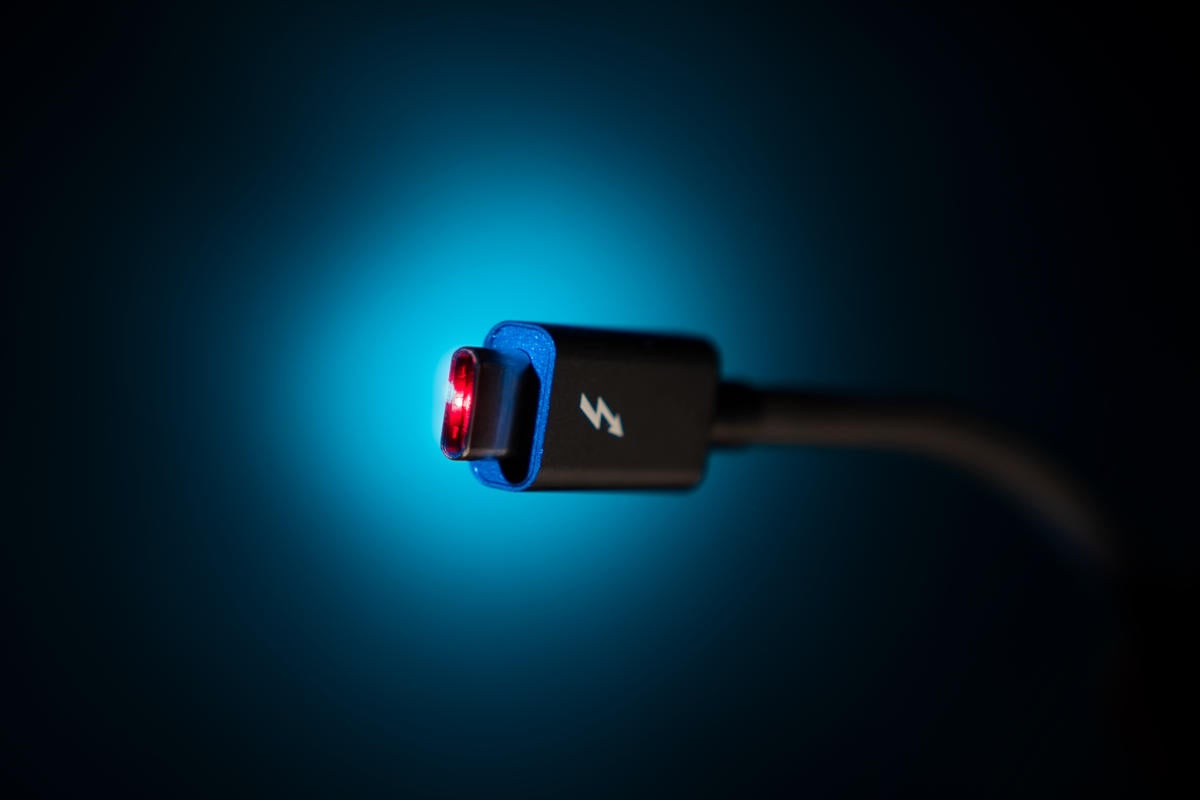
Intel Thunderbolt cables and ports include the little lightning-bolt icon, which differentiates them from the otherwise unmarked USB-C cables.
Because USB-C is common to both Macs, Windows PCs, and phones, some hubs push their allegiance to a particular market category. Go ahead and use that Anker hub that’s billed as being “for MacBook Pro 2016/2017, Chromebook, and XPS” with any Windows PC—we did, and it works just fine. You won’t even need any special software or drivers.
How we test USB-C hubs
We originally divided this guide into three categories: USB-C to USB-A hubs; a second group that added microSD and SD card slots; and a third, “kitchen sink” collection that would add a variety of additional ports. We were very pleased to discover that some manufacturers offer SD/microSD slots for the price of USB-C to USB-A hubs, so we consolidated those features into one “Basic” category.
We used bus-powered peripherals to test each hub: an SSD, a hard drive, and a rewriteable DVD drive, all to make sure enough power was being delivered. We also ran speed tests on those hubs with ethernet connections, just to detect any anomalous results.
We conducted standardized tests to transfer a file from the SSD to the laptop; from the hard drive to the SSD; and then from an SD card to the PC, while simultaneously transferring files from the hard drive to the SSD. In almost all cases, the performance was identical, with a spread of about 3 percent—good news for you, as that’s one less thing to worry about.
We measured the surface temperature while these tests were run. You’ll see some buyers on Amazon pages complaining about how hot a hub gets; some do get on the warmer side.
We looked at how SD cards were inserted—you’d be surprised how many don’t work unless they’re inserted upside down!
We noted the cord length, as shorter cables limit your options when positioning the hub around your laptop or tablet. Worst case, a short cable causes a hub to dangle from a tablet whose USB-C port is mounted toward the top. We’d also recommend avoiding any hubs that connect directly to the port rather than using a cord, as they can block other ports.
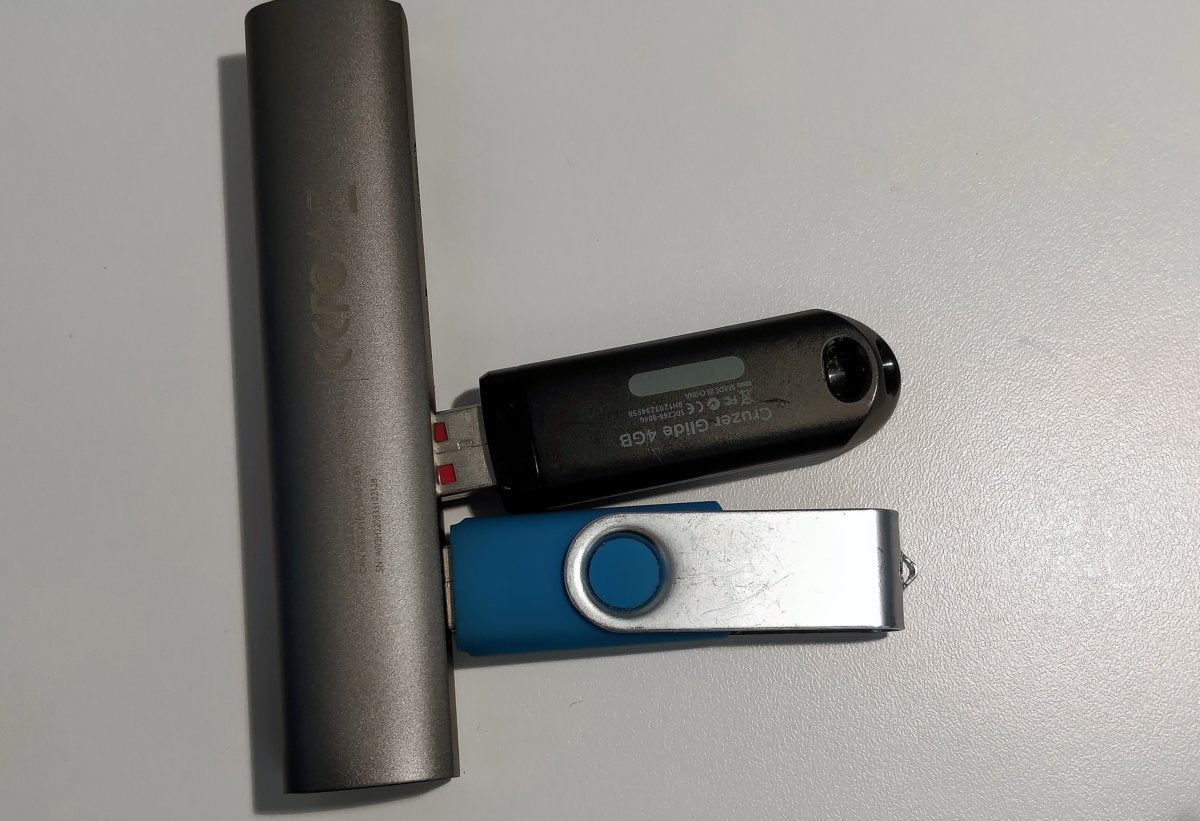
Mark Hachman / IDG Why bother testing something as ridiculous as the spacing between the USB Type A ports? Because if you don’t, you can run into this situation: because the ports are spaced too closely together, only one of these USB keys can be inserted at a time.
After testing about a dozen USB-C hubs, we can confirm that some no-names perform just as well as their more well-known counterparts, and for less money, too. One thing to keep in mind: Because price is so critical to our recommendations, know that some of the prices may change as manufacturers offer sales. Therefore some hubs we didn’t recommend primarily based on price could become more purchase-worthy.
Contact Information:
Mark Hachman
Tags:
, Wire, Artificial Intelligence Newswire, United States, English
Contact Information:
Mark Hachman



